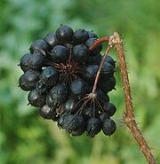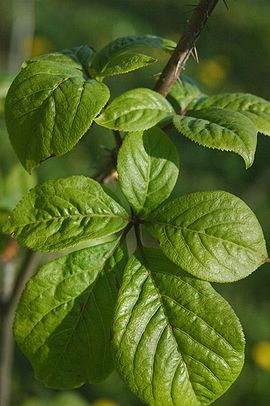
Eleutherococcus senticosus
Encyclopedia
Eleutherococcus senticosus (formerly Acanthopanax senticosus) is a species of small, woody shrub
in the family Araliaceae
native to Northeastern Asia. It is often colloquially referred to as Siberian Ginseng or eleuthero, and is sometimes shortened to E. senticosus in medical literature. E. senticosus has been studied as an adaptogen
, and has a history of use in Chinese medicine, where it is known as cì wǔ jiā (刺五加)..
The herb grows in mixed and coniferous mountain forests, forming low undergrowth or is found in groups in thickets and edges. E. senticosus is sometimes found in oak groves at the foot of cliffs, very rarely in high forest riparian woodland. Its native habitat is East Asia, China, Japan, and Russia. E. senticosus is broadly tolerant of soils, growing in sandy, loamy, and heavy clay soils with acid, neutral, or alkaline chemistry and including soils of low nutritional value. It can tolerate sun or dappled shade and some degree of pollution. E. senticosus is a deciduous
shrub growing to 2m at a slow rate. It is hardy to zone 3. It flowers in July in most habitats. The flowers are hermaphroditic and are pollinated by insects.
E. senticosus is a new addition to Western natural medicine, but has quickly gained a reputation similar to that of the better known and more expensive Chinese Ginseng. Though the chemical make-up of the two herbs differs, their effects seem to be similar. An extensive list of research on E. senticosus with links to PubMed
is available.
The herb is an adaptogen
, is anticholesteremic, is mildly anti-inflammatory
, is antioxidant
, is a nervine, and is an immune tonic. It is useful when the hypothalamic-pituitary-adrenal axis
(HPA) is depleted. Symptoms of this condition include fatigue, stress, neurasthenia, and sore muscles associated with the hypofunctioning of the endocrine system, and adrenal exhaustion indicated by a quivering tongue, dark circles under the eyes, and dilating/contracting pupils. Eleuthero may alleviate these symptoms.
properties to those of Panax ginseng
. However, it belongs to a different genus in the family Araliaceae
, and it is currently illegal in the United States to market eleuthero as Siberian Ginseng, since the term "ginseng" is reserved for the Panax species.
 E. senticosus is an adaptogen
E. senticosus is an adaptogen
that has a wide range of health benefits attributed to its use. Currently, most of the research to support the medicinal use of E. senticosus is in Russian or Korean. E. senticosus contains eleutherosides, triterpenoid saponins that are lipophilic and that can fit into hormone receptors. Extracts of E. senticosus have been shown to have a variety of biological effects in vitro
or in animal models:
Chinese herbology, Eleutherococcus senticosis is used to treat bone marrow suppression caused by chemotherapy or radiation, angina, hypercholesterolemia, and neurasthenia with headache, insomnia, and poor appetite.
Eleutherococcus senticosus has been shown to have significant antidepressant-like effects in rats.
Shrub
A shrub or bush is distinguished from a tree by its multiple stems and shorter height, usually under 5–6 m tall. A large number of plants may become either shrubs or trees, depending on the growing conditions they experience...
in the family Araliaceae
Araliaceae
Araliaceae is a family of flowering plants, also known as the Aralia family or Ivy family. The family includes 254 species of trees, shrubs, lianas and perennial herbaceous plants into 2 subfamilies...
native to Northeastern Asia. It is often colloquially referred to as Siberian Ginseng or eleuthero, and is sometimes shortened to E. senticosus in medical literature. E. senticosus has been studied as an adaptogen
Adaptogen
An adaptogen is a herbal product claimed to increase resistance to stress, trauma, anxiety and fatigue. The term is used mainly by herbalists who also refer to adaptogens as rejuvenating herbs, qi tonics, rasayanas, or restoratives...
, and has a history of use in Chinese medicine, where it is known as cì wǔ jiā (刺五加)..
The herb grows in mixed and coniferous mountain forests, forming low undergrowth or is found in groups in thickets and edges. E. senticosus is sometimes found in oak groves at the foot of cliffs, very rarely in high forest riparian woodland. Its native habitat is East Asia, China, Japan, and Russia. E. senticosus is broadly tolerant of soils, growing in sandy, loamy, and heavy clay soils with acid, neutral, or alkaline chemistry and including soils of low nutritional value. It can tolerate sun or dappled shade and some degree of pollution. E. senticosus is a deciduous
Deciduous
Deciduous means "falling off at maturity" or "tending to fall off", and is typically used in reference to trees or shrubs that lose their leaves seasonally, and to the shedding of other plant structures such as petals after flowering or fruit when ripe...
shrub growing to 2m at a slow rate. It is hardy to zone 3. It flowers in July in most habitats. The flowers are hermaphroditic and are pollinated by insects.
E. senticosus is a new addition to Western natural medicine, but has quickly gained a reputation similar to that of the better known and more expensive Chinese Ginseng. Though the chemical make-up of the two herbs differs, their effects seem to be similar. An extensive list of research on E. senticosus with links to PubMed
PubMed
PubMed is a free database accessing primarily the MEDLINE database of references and abstracts on life sciences and biomedical topics. The United States National Library of Medicine at the National Institutes of Health maintains the database as part of the Entrez information retrieval system...
is available.
The herb is an adaptogen
Adaptogen
An adaptogen is a herbal product claimed to increase resistance to stress, trauma, anxiety and fatigue. The term is used mainly by herbalists who also refer to adaptogens as rejuvenating herbs, qi tonics, rasayanas, or restoratives...
, is anticholesteremic, is mildly anti-inflammatory
Anti-inflammatory
Anti-inflammatory refers to the property of a substance or treatment that reduces inflammation. Anti-inflammatory drugs make up about half of analgesics, remedying pain by reducing inflammation as opposed to opioids, which affect the central nervous system....
, is antioxidant
Antioxidant
An antioxidant is a molecule capable of inhibiting the oxidation of other molecules. Oxidation is a chemical reaction that transfers electrons or hydrogen from a substance to an oxidizing agent. Oxidation reactions can produce free radicals. In turn, these radicals can start chain reactions. When...
, is a nervine, and is an immune tonic. It is useful when the hypothalamic-pituitary-adrenal axis
Hypothalamic-pituitary-adrenal axis
The hypothalamic-pituitary-adrenal axis , also known as thelimbic-hypothalamic-pituitary-adrenal axis and, occasionally, as the hypothalamic-pituitary-adrenal-gonadotropic axis, is a complex set of direct influences and feedback interactions among the hypothalamus, the pituitary gland ,...
(HPA) is depleted. Symptoms of this condition include fatigue, stress, neurasthenia, and sore muscles associated with the hypofunctioning of the endocrine system, and adrenal exhaustion indicated by a quivering tongue, dark circles under the eyes, and dilating/contracting pupils. Eleuthero may alleviate these symptoms.
Synonyms
E. senticosus was previously marketed in the United States as Siberian Ginseng because it has similar herbalHerbalism
Herbalism is a traditional medicinal or folk medicine practice based on the use of plants and plant extracts. Herbalism is also known as botanical medicine, medical herbalism, herbal medicine, herbology, herblore, and phytotherapy...
properties to those of Panax ginseng
Ginseng
Ginseng is any one of eleven species of slow-growing perennial plants with fleshy roots, belonging to the genus Panax of the family Araliaceae....
. However, it belongs to a different genus in the family Araliaceae
Araliaceae
Araliaceae is a family of flowering plants, also known as the Aralia family or Ivy family. The family includes 254 species of trees, shrubs, lianas and perennial herbaceous plants into 2 subfamilies...
, and it is currently illegal in the United States to market eleuthero as Siberian Ginseng, since the term "ginseng" is reserved for the Panax species.
Ethnomedical use

Adaptogen
An adaptogen is a herbal product claimed to increase resistance to stress, trauma, anxiety and fatigue. The term is used mainly by herbalists who also refer to adaptogens as rejuvenating herbs, qi tonics, rasayanas, or restoratives...
that has a wide range of health benefits attributed to its use. Currently, most of the research to support the medicinal use of E. senticosus is in Russian or Korean. E. senticosus contains eleutherosides, triterpenoid saponins that are lipophilic and that can fit into hormone receptors. Extracts of E. senticosus have been shown to have a variety of biological effects in vitro
In vitro
In vitro refers to studies in experimental biology that are conducted using components of an organism that have been isolated from their usual biological context in order to permit a more detailed or more convenient analysis than can be done with whole organisms. Colloquially, these experiments...
or in animal models:
- increased endurance/anti-fatigue
- memory/learning improvement
- anti-inflammatory
- immunogenic
Chinese herbology, Eleutherococcus senticosis is used to treat bone marrow suppression caused by chemotherapy or radiation, angina, hypercholesterolemia, and neurasthenia with headache, insomnia, and poor appetite.
Eleutherococcus senticosus has been shown to have significant antidepressant-like effects in rats.
Chemical constituents
The major constituents of E. senticosus are ciwujianoside A-E, eleutheroside B (syringin), eleutherosides A-M, friedelin, and isofraxidin.Interactions and side effects
- People with medicated high blood pressure should consult their doctor before taking E. senticosus because it may reduce their need for medication.
- E. senticosus will enhance the effectiveness of mycin classMacrolideThe macrolides are a group of drugs whose activity stems from the presence of a macrolide ring, a large macrocyclic lactone ring to which one or more deoxy sugars, usually cladinose and desosamine, may be attached. The lactone rings are usually 14-, 15-, or 16-membered...
antibiotics. - E. senticosus, when purchased from non-GMPGood Manufacturing Practice"Good manufacturing practice" or "GMP" are practices and the systems required to be adapted in pharmaceutical manufacturing, quality control, quality system covering the manufacture and testing of pharmaceuticals or drugs including active pharmaceutical ingredients, diagnostics, foods,...
sources, has occasionally been adulterated with Periploca graecaPeriploca graecaPeriploca graeca, the Silk Vine is an ornamental plant in the Apocynaceae family.-External links:* photo* - ibiblio.org...
, which can potentiate digoxinDigoxinDigoxin INN , also known as digitalis, is a purified cardiac glycoside and extracted from the foxglove plant, Digitalis lanata. Its corresponding aglycone is digoxigenin, and its acetyl derivative is acetyldigoxin...
or similar drugs; however, this is not an interaction of E. senticosus.

